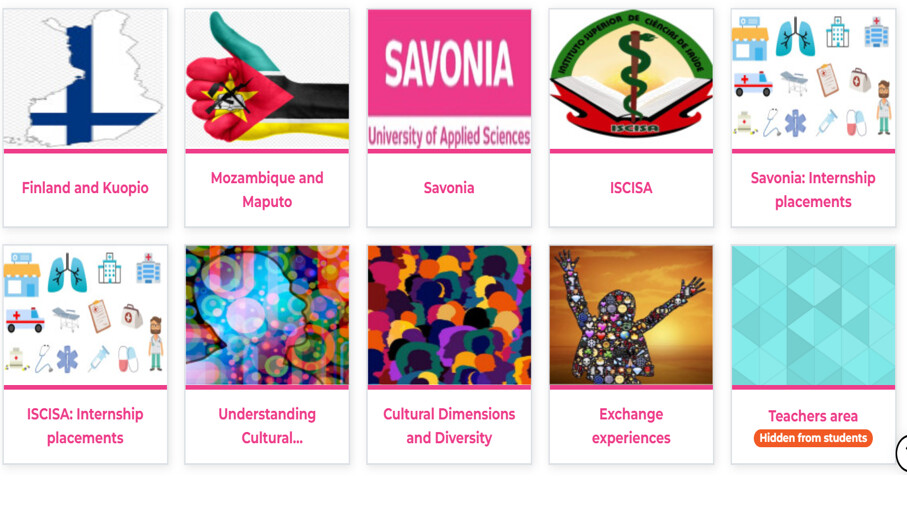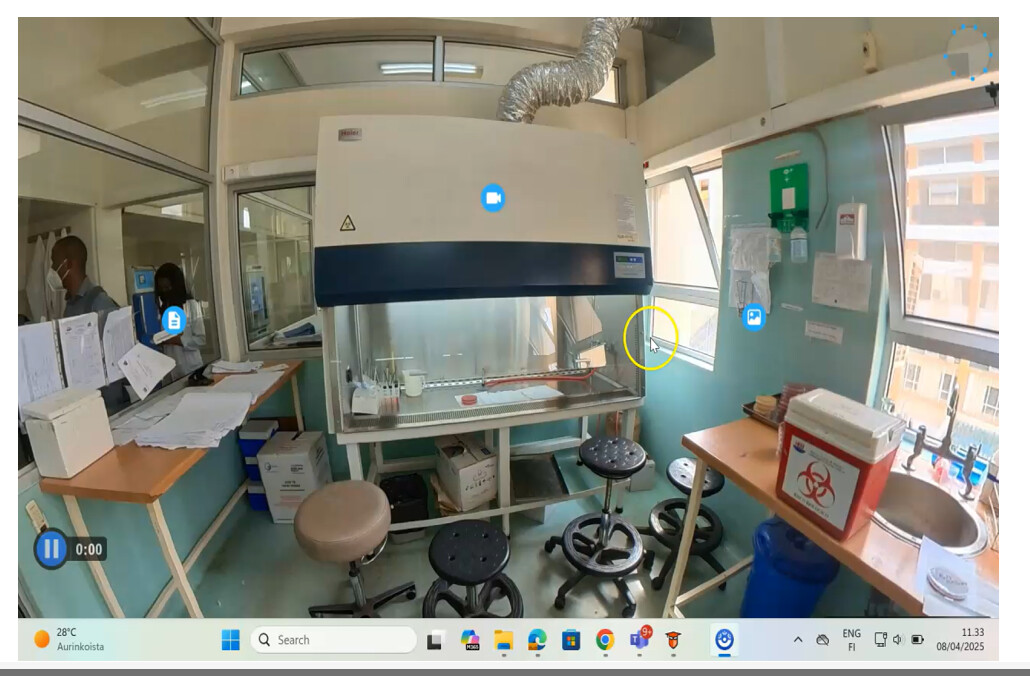
Savonia Article: Virtual learning environment (VLE) for the internship process between Savonia and ISCISA students.
This work is licensed under CC BY-SA 4.0
Introduction
In an increasingly globalized and digitally connected world, Virtual Learning Environment (VLE) and other digital learning platforms have emerged as vital tools for enhancing international academic collaboration and experiential learning. One such initiative is the development of a VLE designed to support the internship process between students from Savonia University of Applied Sciences in Finland and the Instituto Superior de Ciências de Saúde (ISCISA) in Mozambique. By integrating digital tools with professional training, the VLE provides a structured and flexible framework that enhances the quality and accessibility of internships for students from diverse academic and cultural backgrounds. This article is part of series developed on Erasmus+ Global project that aimed to design and set up of Virtual learning environment (VLE); create materials which prepares students and teachers for the internships and create cultural Competence for online leaning material. We aim to break education geographical gaps and foster intercultural exchange in health care education, streamline the supervision, communication, and assessment of internships.
Virtual learning environments
In this article, the virtual learning environment (VLE) is a digital ecosystem designed to enhance student engagement and learning outcomes by integrating several technologies: Moodle learning platforms, 360-degree images and interactive learning materials (Figure 1).

Moodle Learning Platform which is an open-source learning management system (LMS), widely used in education for delivering online courses. The key features are course management (scheduling, assignments, grading); communication tools (forums, messages, feedback) and the integration with multimedia and plugins. Moodle learning platform plays important role serving as the central hub where students access content, submit assignments, take quizzes, and interact with instructors and peers.
In this project were used 360-Degree images as a apart of VLE. These images are panoramic images that allow users to look around in all directions, simulating a real-world environment and experience created by the technology that can capture images using 360-degree cameras. These images are used in VLE to simulate real-life settings (e.g., labs, field sites, or clinical environments) and can offer immersive experiences, increasing the sense of presence and realism. It also helps bridge the gap between theoretical learning and practical application.
VLE also uses Interactive Learning Material that includes multimedia content such as videos, quizzes, clickable diagrams, drag-and-drop exercises, simulations, and interactive case studies of VLE combined with different components (Moodle, 360-degree images, Interactive materials) creates a rich, multisensory learning experience that supports better retention, deeper understanding, and more flexible, student-centered education.
Erasmus+ Global project offered a unique opportunity for teachers and students to develop VLE competences during mobilities and joining virtual meetings and ISCISA teachers getting to know e-learning environments from SAVONIA like Edunia Moodle platform. During the period was built joint Moodle platform as shown in Fig 2.( (https://edunia.savonia.fi/course/view.php?id=19) That consist of various information related cultural and professional competences.

360-degree images and the use of Thinglink integration
Moodle, a widely used open-source learning management system (LMS), can be enhanced with interactive 360-degree images to support more engaging and experiential learning. This is especially useful in programs such as medical or laboratory sciences, where real-world environments (e.g., hospitals, labs) are crucial to student learning. One effective tool for creating and embedding these interactive experiences is ThingLink, a digital platform that allows users to upload panoramic or 360-degree images and enrich them with interactive tags.
Virtual exploration with 360-degree images
These images allow students to virtually explore real environments such as hospital wards, laboratories, or diagnostic rooms. It simulates the experience of being physically present, helping students become familiar with the setting before actual internships or clinical placements. For example, a 360-degree image of a hospital’s emergency room can give students a full view of where they may be placed during training. ThingLink allows the addition of interactive tags to specific areas in the 360° image. These tags can contain: texts for descriptions of equipment, procedures, or protocols; images for High-resolution photos of tools, lab setups, or staff members; videos for tutorials, walkthroughs, or interviews with professionals; audios for narrations or explanations to guide learners and hyperlinks for Direct links to Moodle resources, PDFs, or relevant external websites.
Seamless integration into Moodle and the benefits of this approach
ThingLink content can be embedded into Moodle using iframes or LTI (Learning Tools Interoperability) where students can access these interactive scenes directly within their Moodle course modules, creating a cohesive learning experience and teachers can align these visuals with course outcomes, assignments, or assessments. This holds benefits for an increased Engagement in interactive media that holds student attention better than static text, help learners grasp spatial relationships and processes. Students who cannot visit physical sites can still gain exposure to professional environments and learners can explore at their own speed and revisit as needed.

Description of results
The development of the Virtual Learning Environment (VLE) has reached an important milestone with the completion of its first functional version. This initial release has been made available for use in the context of internship programs involving both students and teachers, marking a key step in digitalizing and enhancing the learning experience.
Feedback gathered from the initial working group—composed of educators, technical staff, and coordinators—has been encouraging. Users reported that the VLE’s structure, content, and usability align well with the practical needs of internships. This feedback confirms that the environment is both accessible and supportive, offering relevant learning materials, guidelines, and communication tools that complement on-site internship activities.
To further refine the platform, a series of pilot implementations have been launched:
- The first phase involves student users from both Savonia and ISCISA, allowing the project team to observe how learners interact with the VLE and which aspects require adjustment or improvement.
- The second phase focuses on teacher use, exploring how academic staff engage with the platform for supervision, resource sharing, and feedback during internships.
Conclusion
Throughout both pilot phases, continuous feedback is being collected using surveys, direct observation, and user reports. This data will guide the ongoing development and optimization of the VLE, ensuring that future interactions are better tailored to the needs of both institutions. These results highlight a promising start for the VLE initiative, demonstrating both technical readiness and strong user engagement.
Authors:
Leonel Monjane, Senior Lecturer, MSc, The head of licentiates degree program in BLS, radiography, and Pathologic Anatomy at Instituto Superior de Ciências de Saúde (ISCISA), leonelfidalgomonjane@gmail.com
Anssi Mahonen, Senior Lecturer, PhD. The head of master degree program in BLS and radiography. Savonia University of Applied Sciences, School of Health Care, Anssi.Mahonen@savonia.fi